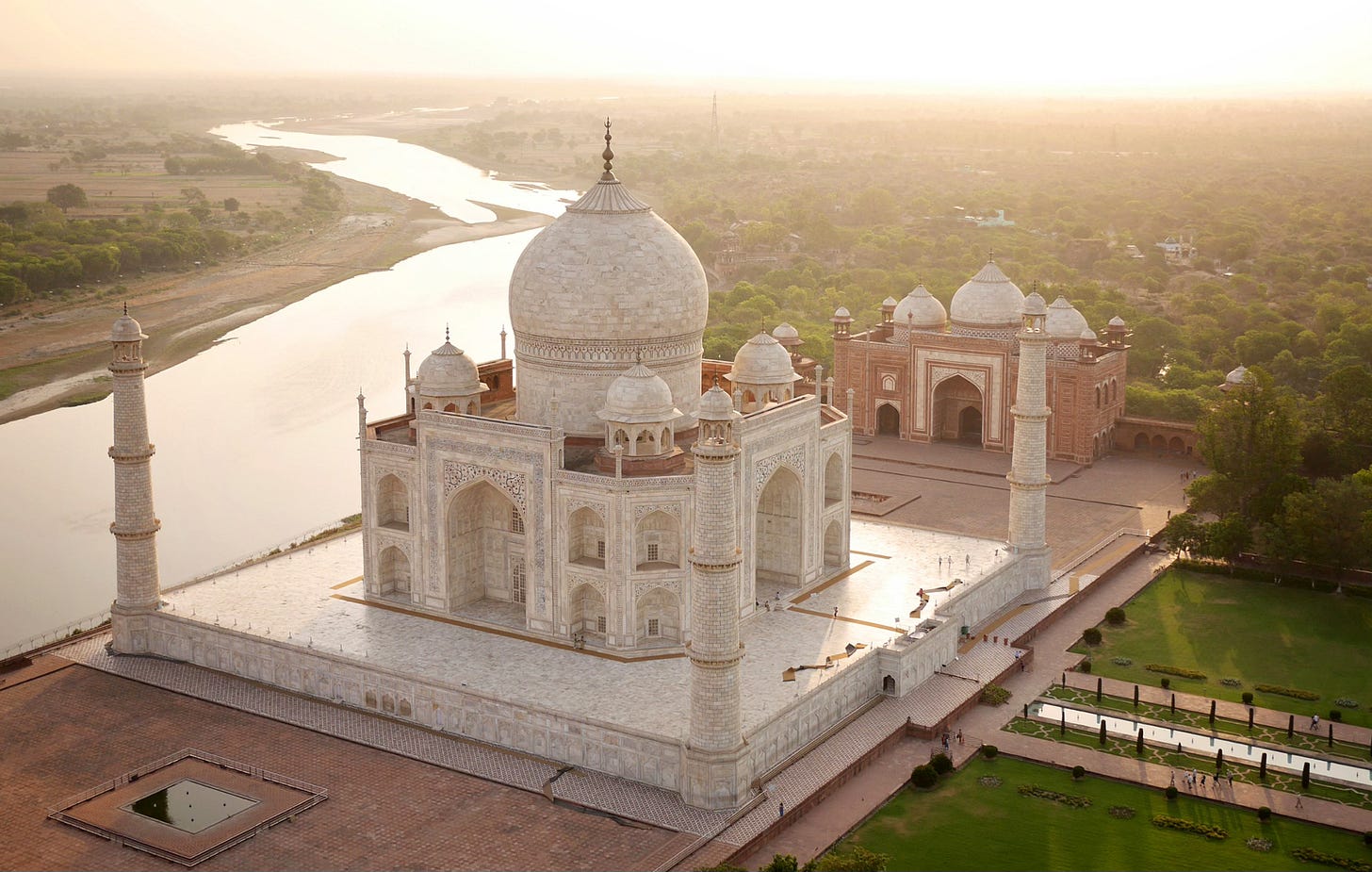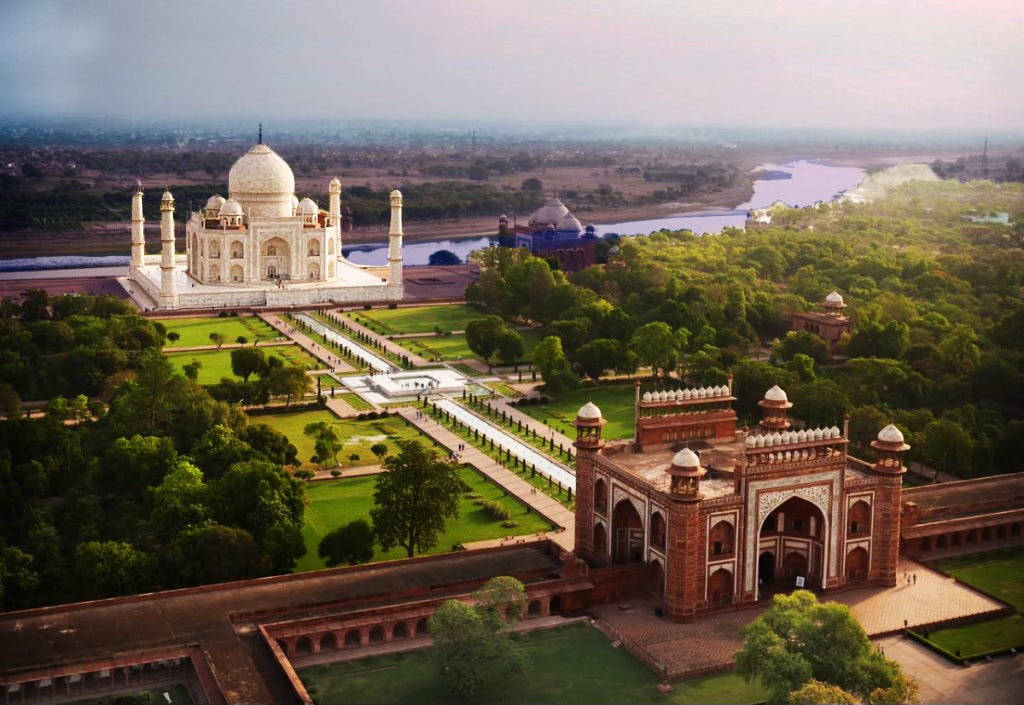The Taj Mahal
The Power of a Love Story
On my sixteenth birthday, I was given the opportunity to pick a destination of my choice. An avid history and literature student, I selected the Taj Mahal in Agra, India. To my delight, my parents were thrilled with my preference, not only by the mere fact that the location was in India, but also it meant we could visit my grandmother in Pune and then onto Agra.
The prospect of visiting the Taj Mahal, one of the most iconic and magnificent wonders of the world, filled me with a sense of excitement and anticipation. As a student passionate about history and culture, the opportunity to witness this architectural masterpiece in person was a dream come true.
The journey to India was an adventure in itself. Travelling to Pune to see my grandmother allowed me to connect with my roots and immerse myself in the vibrant Indian culture that shaped my identity and defined who I am. The bustling streets, neighbors who were a constant in our family, the delicious flavors and the warm hospitality of my family only heightened my eagerness to explore the Taj Mahal.
A Summer Sojourn
It was a crisp, clear morning in Agra when I first laid eyes on the Taj Mahal. I had dreamed of this moment, enthralled by the stories of its breathtaking beauty and the tragic love story that inspired its construction. I believe I lost my parents a couple of times as I raced to keep up with our tour guide trying to get as close as I possibly could so as not to miss a single story.
As I approached the towering white marble mausoleum, my heart raced with a mix of anticipation and reverence. Nothing could have prepared me for the sheer scale and grandeur of the Taj Mahal, or the profound sense of wonder that overwhelmed me as I stepped into its serene gardens.
The intricate calligraphy, delicate floral motifs, and perfect symmetry of the formation left me spellbound, transfixed by the timeless elegance before me. In that moment, I understood why the Taj Mahal is considered one of the world’s most magnificent and captivating wonders. I also knew at that moment that one day I would surely come back here again.
Years later, I stood in the same spot with my teenage daughters, I was filled with a deep desire to share this transformative impression with them, to pass on the sense of admiration I had felt, and to inspire them to appreciate the Taj Mahal’s enduring legacy of love, beauty, and cultural heritage.
A New Perspective
The drive to the Taj Mahal was a lively and vigorous journey, offering a glimpse into the bustling energy of Agra’s streets before the grand reveal of the monument itself.
As our car pulled out of the hotel, we were immediately immersed in the cacophony of the city’s main thoroughfare. The road was alive with activity – a constant flow of cars, rickshaws, bicycles, and pedestrians all jockeying for position, horns honking and engines revving. Our driver navigated this chaotic dance with practiced skill, weaving between lanes and deftly swerving to avoid stray dogs and cows that ambled across the pavement.
The streets were a riot of color and movement – shops and stalls lining the sides, their owners hawking wares, while passersby hurried by, lost in their own rhythms. Vendors pushed carts laden with fresh produce: alphonso and kesar mangoes, guava, coconuts, corn on the cob, to wash down with: lassi, thandai, masala tea, sugar cane juice, some of the savory regional cuisines of Punjab, Rajasthan, and Gujarati snacks: pani puri, chaat, hot savory snacks: aloo tiki, chole bhature, kachori, samosa, paranthe, and kebabs, the food of the Mughals, finishing off with sweets: jalebi, mava, gulab jamun, rabri falooda and many such mouthwatering delicacies.
My girls who had been visibly energized by the chaos of the city streets, suddenly slowed their pace, eyes wide with wonder as they took in the tranquil beauty surrounding them. The tension seemed to melt from their shoulders, and they walked with a newfound sense of admiration.
It was as if the Taj Mahal had the power to transport us to a realm removed from the hustle and bustle of the outside world – a sanctuary of beauty, contemplation, and emotional resonance. The stark juxtaposition of the colorful city and the hushed splendor of the Taj Mahal gardens served to highlight the monument’s ability to evoke a sense of profound calm and wonder, even amidst the chaos of the surrounding environment.
I had been mesmerized by sheer scale, design and brilliance, senses overwhelmed by the complex details and the poignant love story that had inspired its creation.
But now my perspective had shifted. Watching my daughters’ reactions as they stood before the towering white marble domes and minarets, I was struck by the ways in which the Taj could enchant and influence a new generation. Their wide-eyed wonder, their eager questions about the history and symbolism, and their palpable sense of reverence mirrored my own initial acquaintance yet were imbued with a fresh energy and innocence.
In a sense I was able to relive my epiphany through their eyes. Yet, at the same time, I found myself cherishing the Taj in a more nuanced way – as a tangible manifestation of enduring human emotion, as a testament to the power of love to transcend time and culture, and as a source of profound everlasting genius.

Sense of Timelessness
The tragic love story behind the Taj’s construction was a particular point of fascination.
My girls were deeply moved by the tale of the Mughal emperor Shah Jahan’s devotion to his beloved wife, Mumtaz Mahal, and his desire to create a fitting memorial that would immortalize their love. They listened intently as I recounted the story of Mumtaz’s untimely death and Shah Jahan’s grief, and how this profound sorrow emboldened him to commission the construction of one of the world’s most legendary and enduring moments.
In witnessing their rapt attention and their thoughtful questions, I was reminded of my own teenage acquaintance with the Taj. A joy to pass on the sense of wonder and appreciation to the next generation. It was precisely then that we saw my cousin with his family from Hong Kong, visiting the Taj. What were the chances of us, from opposite sides of the world, converging at this iconic monument on the same day?
This unexpected reunion, amidst the serene splendor of the Taj Mahal, left an indelible mark on my conversance with the Taj, further reinforcing the profound impact that this trip had on my sense of identity and my place within the larger global community.
Dazzling Artistry
We strolled along together with my cousin and his family through verdant gardens, looking back and admiring the free-standing minarets, pillars, and domes. The colossal white marble mausoleum, with its detailed inscriptions and delicate motifs, stood in stately silence, commanding attention of al who gazed upon it. The perfect symmetry, harmonious integration, the serene gardens all created a sense of timeless serenity.
It was only seconds before we turned our full attention to the fruit trees, taking in the splendid horticulture that beckoned us. The Taj Gardens with banyan trees, geophytes plants including daffodil, hyacinth, iris, narcissus, orchid and tulip. Then there are the seasonal blooms such as marigolds, roses, and jasmine that perfume the air as the prominent pink lotus flowers stay afloat on the famed reflecting pools leading up to the Taj Mahal.
A careful selection and placement of these plants and flowers not only enhance the beauty of the Taj’s setting but also reflect the Mughal preference for harmonious, symmetrical garden design and integration of nature into horticultural grandeur.
The gardens serve an important functional purpose as well. The carefully engineered irrigation system and the selection of indigenous plant species help to create a microclimate that maintains a comfortable temperature and humidity level around the Taj, preserving the delicate marble structure. The serene waterways and reflecting pools that mirror the stunning Taj, all create a sense of tranquility and contemplation, inviting visitors to slow down and appreciate the harmonious relationship between the built and natural elements!
The Taj’s architectural and cultural significance can evoke a sense of wholeness-a harmonious integration of beauty, history, and wonderment together with serenity that nourishes one’s wellbeing. It was these thoughts that we shared in our conversations as we continued our stroll together.

A Reflection of Love
The love story behind the Taj Mahal still holds a profound and lasting influence, even in the modern era. Taj’s origins as a mausoleum built by Shah Jahan as a tribute to his beloved wife, Mumtaz Mahal, is a symbol of eternal love and devotion and a central part of its cultural significance.
Shah Jahan carved his love for his beloved Mumtaz through poetry in stones, ivory and gems. Structurally resplendent, the building features exquisite craftsmanship of delicate filigree and geometric patterns in marble. Precious and semi-precious stones are used throughout the design, adding an elegant and luxurious touch. Gemstones such as agate, amethyst, black onyx, jasper, and lapis lazuli were inlaid by hand.
This amalgamation of aesthetics creates a distinctive composition unveiling the Mughal Empire, a Masterpiece!
Framing the Taj Mahal’s history through the lens of a powerful love story which is emotionally engaging has enraptured people for centuries. Both a regal wonder and a gateway to understanding India’s complex and fascinating history.
Most importantly, this visit underscored the immense value of engaging with history firsthand. Walking the halls of the Taj, we were reminded that the past does not merely sit frozen in time but continues to shape and influence us in the present.








